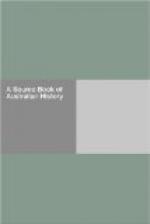The religious feelings of the occasion were stirred by the singing of the grand “Old Hundredth” to the words of the metrical psalm, commencing “All people that on earth do dwell.” This was taken up by thousands of the audience, and its swelling harmonies rose grandly to the dome. Lord Hopetoun, setting aside all complicated questions of religious precedence, himself read several prayers, in his clear, penetrating voice, so pleasantly familiar in Victoria.
When the Duke stepped forward to deliver his speech to the two Houses, a “Hush” ran round the assembly, and everyone listened intently, but the sound of the ever-moving feet on the boarded floors went on. His Royal Highness spoke deliberately, in a clear, strong voice, and the speech he read was distinctly heard by thousands of those present. It was a dignified, a graceful, a kindly, and a congratulatory speech, and it expressed a confident belief that the new powers granted to Australia will only strengthen the affection of the people for the throne and empire.
At the final words, “I now declare the Parliament of the Commonwealth of Australia open,” the Duchess touched an electric button which gave the signal outside for the hoisting of the Union Jack on all the State schools of the Colony, and for the sending of a message to England declaring the object of the journey of the Royal envoys accomplished. Trumpets rang out the signal, and outside was heard the booming of cannon in royal salute.
After a brief pause the Duke of Cornwall and York stepped forward once more and read a special cable message of congratulation from His Majesty the King. And now Australia asserted herself. She had been suppressing her feelings to show that she knew how to behave with old-world decorum in the presence of Royalty, but this message, direct from the King himself, was too much—they simply had to cheer. And cheer they did. It was done without order or without concert. It was taken up time after time by sections of the audience; it ran round the aisles, and surged through the galleries; a hearty, spontaneous, irrepressible Australian cheer. It was not down in the programme, but it formed a most effective part of it.
The final part of the ceremony, which altogether occupied about three-quarters of an hour, was the swearing-in of members by the Governor-General. He stood on the dais and read out the oath, whilst the members, Bible in hand, followed him in sections. Then Lord Hopetoun stepped to the front of the dais, and directing the audience by the waving of his hat, called for three cheers for His Royal Highness the Duke, which were given with splendid heartiness, and followed by another round for the Duchess, after which the Duke and Duchess retired and the great ceremony was over.
TELEGRAM FROM THE KING
His Royal Highness read the following telegram from His Majesty the King:




